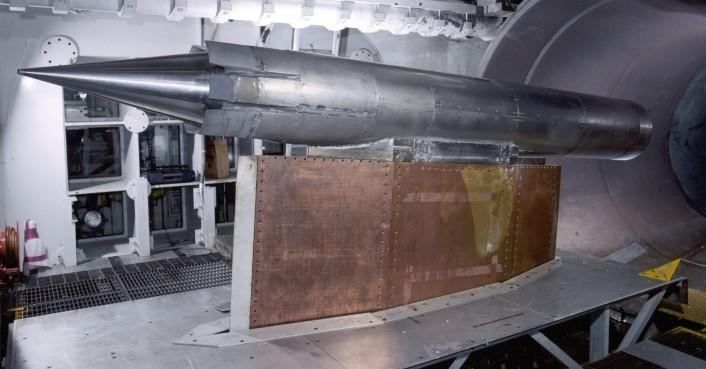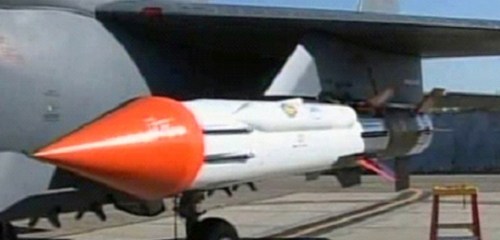Boeing HyFly
The HyFly program was initiated in 2002 by DARPA (Defense Advanced Research Projects Agency) and the U.S. Navy's ONR (Office of Naval Research) to develop and test a demonstrator for a hypersonic Mach 6+ ramjet-powered cruise missile. Prime contractor for the HyFly missile is Boeing, while Aerojet builds the sustainer engine. The vehicle is air-launched from an F-15E aircraft, and is accelerated to ramjet ignition speed by a solid-propellant rocket booster.
The sustainer engine of HyFly is a so-called dual-combustion ramjet (DCR). It is a complex design with two different air inlet systems, which can operate as a "conventional" ramjet with subsonic combustion , or – for hypersonic speeds – as a "scramjet" (supersonic cumbustion ramjet). Furthermore, Aerojet's engine runs on conventional liquid hydrocarbon fuel (JP-10), which is much easier to handle than cryogenic fuels (LH2) which have been used on other hypersonic scramjet vehicles so far. The DCR concept was developed by the Applied Physics Laboratory (APL) of the Johns Hopkins University, and in May 2002, the APL successfully tested the HyFly engine in a windtunnel at a simulated speed and altitude of Mach 6.5 and 27400 m (90000 ft).
 |
| Photo: Applied Physics Laboratory |
| HyFly engine |
To evaluate the airframe at high speeds before actual flight tests, unpowered subscale HyFly vehicles were launched by ATK atop two-stage Terrier-Orion sounding rockets to speeds of Mach 6 at 18300 m (60000 ft). The latter activities were made under HyFly's FASTT (Freeflight Atmospheric Scramjet Test Technique) sub-program. FASTT culminated in December 2005 with the launch of a subscale live DCR, which flew for 15 seconds under scramjet power at 5815 km/h (5300 fps) and 19200 m (63000 ft).
 |
| Photo: ONR |
| FASTT test vehicle |
Aerojet ground-tested the full-scale DCR engine to simulate ramjet ignition after booster burnout at speeds of Mach 3-4. The first free HyFly flight test occurred in January 2005, when an unpowered airframe was dropped from an F-15E. The flight successfully tested separation from the aircraft as well as basic guidance and control functions. On the second test on 26 August 2005, the HyFly's booster accelerated the vehicle to about Mach 3 to test boost-phase performance. Three more flights were originally planned to test the HyFly's ramjet sustainer engine at speeds up to Mach 6. The first two flights in September 2007 and January 2008, respectively, both failed to reach the planned objectives, but the reasons were not directly related to the new engine technology. The third flight was then scheduled for some time in late 2009, but no information about it has since come forward.
 |
| Photo: ONR |
| HyFly booster test vehicle |
If the program is successful, the HyFly demonstrator could form the starting point for the development of an air- and ship-launched cruise missile with a range of about 1100 km (600 nm) at Mach 6 or 1500 km (800 nm) at Mach 4.
 |
| Image: Aerojet |
| HyFly (cruise missile derivative) |
Specifications
No details on the physical characteristics of the HyFly demonstrator are available.
Main Sources
[1] DARPA Website
[2] APL Technology Cornerstone of First Fully Integrated
Hypersonic Cruise Missile Engine Test, APL Press Release, 17 June 2002
[3] Boeing Completes Successful Boost Test of HyFly Hypersonic
Demonstrator, Boeing Press Release, 17 October 2005
Back to Directory of U.S. Military Rockets and Missiles, Appendix 4
Last Updated: 23 November 2009